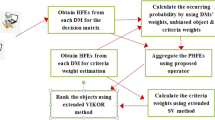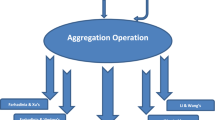Abstract
As an important extension of fuzzy number, the probabilistic hesitant fuzzy element (PHFE) shows the flexibility of decision makers in expressing hesitant information in multi-criteria decision-making (MCDM) processes. Accordingly, numerous research findings have been obtained since PHFE introduction. However, a few important issues in PHFE utilization remain to be addressed. This study introduces the French organization Rangement Et Synthese De Ronnees Relationnelles’ (ORESTE) approach for MCDM with probabilistic hesitant fuzzy information. First, the limitations of normalized PHFE (NPHFE), Euclidean distance, and several operations in previous studies are discussed. Subsequently, an algorithm is designed to derive the new NPHFE. A new Euclidean distance and several operations are developed on the basis of the proposed NPHFE. Second, the ORESTE approach is extended to probabilistic hesitant fuzzy environments. Lastly, the problem of selecting best research topic is presented to demonstrate that the proposed approach is effective. A comparative study with other approaches is conducted with identical illustrative example.

Similar content being viewed by others
Explore related subjects
Discover the latest articles, news and stories from top researchers in related subjects.References
Yu SM, Wang J, Wang JQ, Li L (2018) A multi-criteria decision-making model for hotel selection with linguistic distribution assessments. Appl Soft Comput 67:741–755
Cheng SH (2018) Autocratic decision making using group recommendations based on hesitant fuzzy sets for green hotels selection and bidders selection. Inf Sci 467:604–617
Zhang XY, Wang XK, Yu SM, Wang JQ, Wang TL (2018) Location selection of offshore wind power station by consensus decision framework using picture fuzzy modelling. J Clean Prod 202:980–992
Nie RX, Tian ZP, Wang JQ, Zhang HY, Wang TL (2018) Water security sustainability evaluation: applying a multistage decision support framework in industrial region. J Clean Prod 196:1681–1704
Zhao R, Liu SL, Liu YY, Zhang LP, Li YP (2018) A safety vulnerability assessment for chemical enterprises: a hybrid of a data envelopment analysis and fuzzy decision-making. J Loss Prev Process Ind 56:95–103
Wu HY, Xu ZS, Ren PJ, Liao HC (2018) Hesitant fuzzy linguistic projection model to multi-criteria decision making for hospital decision support systems. Comput Ind Eng 115:449–458
Ren JZ, Liang HW (2017) Measuring the sustainability of marine fuels: a fuzzy group multi-criteria decision making approach. Transp Res Part D Transp Environ 54:12–29
Liu YJ, Zhang WG, Gupta P (2018) International asset allocation optimization with fuzzy return. Knowl Based Syst 139:189–199
Aggarwal M (2019) Hesitant information sets and application in group decision making. Appl Soft Comput 75:120–129
Torra V (2010) Hesitant fuzzy sets. Int J Intell Syst 25:529–539
Zhou W, Xu ZS (2018) Probability calculation and element optimization of probabilistic hesitant fuzzy preference relations based on expected consistency. PP, IEEE Trans Fuzzy Syst, pp 1367–1378
Li J, Wang JQ, Hu JH (2019) Consensus building for hesitant fuzzy preference relations with multiplicative consistency. Comput Ind Eng 128:387–400
Dinçer H, Yüksel S, Martínez L (2019) Analysis of balanced scorecard-based SERVQUAL criteria based on hesitant decision-making approaches. Comput Ind Eng 131:1–12
Hussain Z, Yang MS (2018) Entropy for hesitant fuzzy sets based on Hausdorff metric with construction of hesitant fuzzy TOPSIS. Int J Fuzzy Syst 20:2517–2533
Xu ZS, Zhang S (2019) An overview on the applications of the hesitant fuzzy sets in group decision-making: theory, support and methods. Front Eng Manag 6:163–182
Zhu B. Decision method for research and application based on preference relation., Retrieved from China Dissertation Database
Li J, Wang ZX (2019) Multi-attribute decision-making based on prioritized operators under probabilistic hesitant fuzzy environments. Soft Comput 23:3853–3868
Xu ZS, Zhou W (2017) Consensus building with a group of decision makers under the hesitant probabilistic fuzzy environment. Fuzzy Optim Decis Making 16:481–503
Zhang S, Xu ZS, He Y (2017) Operations and integrations of probabilistic hesitant fuzzy information in decision making. Inf Fus 38:1–11
Hao ZN, Xu ZS, Zhao H, Su Z (2017) Probabilistic dual hesitant fuzzy set and its application in risk evaluation. Knowl Based Syst 127:16–28
Jiang FJ, Ma QG (2018) Multi-attribute group decision making under probabilistic hesitant fuzzy environment with application to evaluate the transformation efficiency. Appl Intell 48:953–965
Zhang S, Xu ZS, Wu HY (2019) Fusions and preference relations based on probabilistic interval-valued hesitant fuzzy information in group decision making. Soft Comput 23:8291–8306
Ding J, Xu ZS, Zhao N (2017) An interactive approach to probabilistic hesitant fuzzy multi-attribute group decision making with incomplete weight information. J Intell Fuzzy Syst 32:2523–2536
He Y, Xu ZS (2019) Multi-attribute decision making methods based on reference ideal theory with probabilistic hesitant information. Expert Syst Appl 118:459–469
Tian XL, Xu ZS, Fujita H (2018) Sequential funding the venture project or not? A prospect consensus process with probabilistic hesitant fuzzy preference information. Knowl Based Syst 161:172–184
Song CY, Xu ZS, Zhao H (2019) New correlation coefficients between probabilistic hesitant fuzzy sets and their applications in cluster analysis. Int J Fuzzy Syst 21:355–368
Xu ZS, He Y, Wang XZ (2019) An overview of probabilistic-based expressions for qualitative decision-making: techniques, comparisons and developments. Int J Mach Learn Cybern 10:1513–1528
Li J, Wang JQ (2017) An extended QUALIFLEX method under probability hesitant fuzzy environment for selecting green suppliers. Int J Fuzzy Syst 19:1866–1879
Li J, Wang JQ (2017) Multi-criteria outranking methods with hesitant probabilistic fuzzy sets. Cogn Comput 9:611–625
Li J, Wang JQ, Hu JH (2019) Multi-criteria decision-making method based on dominance degree and BWM with probabilistic hesitant fuzzy information. Int J Mach Learn Cybern 10:1671–1685
Zhou W, Xu ZS (2017) Expected hesitant VaR for tail decision making under probabilistic hesitant fuzzy environment. Appl Soft Comput 60:297–311
Krishankumar R, Ravichandran KS, Kar S, Gupta P, Mehlawat MK (2019) Interval-valued probabilistic hesitant fuzzy set for multi-criteria group decision-making. Soft Comput 23:10853–10879
Roubens M (1982) Preference relations an actions and criteria in multicriteria decision making. Eur J Oper Res 10:51–55
Liao HC, Wu XL, Liang XD, Yang JB, Xu DL, Herrera F (2018) A continuous interval-valued linguistic ORESTE method for multi-criteria group decision making. Knowl Based Syst 153:65–77
Liao HC, Wu XL, Liang XD, Xu JP, Herrera F (2018) A new hesitant fuzzy linguistic ORESTE method for hybrid multi-criteria decision making. IEEE Trans Fuzzy Syst 26:3793–3807
Wu XL, Liao HC (2018) An approach to quality function deployment based on probabilistic linguistic term sets and ORESTE method for multi-expert multi-criteria decision making. Inf Fus 43:13–26
Tian ZP, Nie RX, Wang JQ, Zhang HY (2019) Signed distance-based ORESTE for multi-criteria group decision-making with multi-granular unbalanced hesitant fuzzy linguistic information. Expert Syst 36:e12350
Wang XD, Gou XJ, Xu ZS (2020) Assessment of traffic congestion with ORESTE method under double hierarchy hesitant fuzzy linguistic environment. Appl Soft Comput 86:105864
Xia MM, Xu ZS (2011) Hesitant fuzzy information aggregation in decision making. Int J Approx Reason 52:395–407
Wu XL, Liao HC, Xu ZS, Hafezalkotob A, Herrera F (2018) Probabilistic linguistic MULTIMOORA: a multi-criteria decision making method based on the probabilistic linguistic expectation function and the improved borda rule. IEEE Trans Fuzzy Syst 26:3688–3702
Xu YJ, Cabrerizo FJ, Herrera-Viedma E (2017) A consensus model for hesitant fuzzy preference relations and its application in water allocation management. Appl Soft Comput 58:265–284
Wu ZB, Xu JP (2018) A consensus model for large-scale group decision making with hesitant fuzzy information and changeable clusters. Inf Fus 41:217–231
Mu ZM, Zeng SZ, Baležentis T (2015) A novel aggregation principle for hesitant fuzzy elements. Knowl-Based Syst 84:134–143
Xu ZS, Cai XQ (2010) Recent advances in intuitionistic fuzzy information aggregation. Fuzzy Optim Decis Making 9:359–381
Xu ZS, Zhang XL (2013) Hesitant fuzzy multi-attribute decision making based on TOPSIS with incomplete weight information. Knowl Based Syst 52:53–64
Pastijn H, Leysen J (1989) Constructing an outranking relation with ORESTE. Math Comput Model 12:1255–1268
Acknowledgements
The authors thank the anonymous reviewers and the editor for their insightful and constructive comments and suggestions that have led to an improved version of this paper. This work was supported by the National Natural Science Foundation of China (nos.61866006), Guangxi innovation-driven development of special funds project (gui ke AA17204091), the Natural Science Foundation of Guangxi (nos. AB17292095), the Research Funds for the Guangxi University Xingjian College of Science and Liberal Arts (nos. Y2018ZKT01) and Promotion project of Middle-aged and Young Teachers’ Basic Scientific Research Ability in Universities of Guangxi (no. 2019KY0963).
Author information
Authors and Affiliations
Corresponding author
Ethics declarations
Conflict of interest
Author Jian Li, Qiongxia Chen, Li-li Niu and Zhong-xing Wang declare that they have no conflict of interest.
Ethical approval
This article does not contain any studies with human participants performed by any of the authors.
Additional information
Publisher's Note
Springer Nature remains neutral with regard to jurisdictional claims in published maps and institutional affiliations.
Rights and permissions
About this article
Cite this article
Li, J., Chen, Q., Niu, Ll. et al. An ORESTE approach for multi-criteria decision-making with probabilistic hesitant fuzzy information. Int. J. Mach. Learn. & Cyber. 11, 1591–1609 (2020). https://doi.org/10.1007/s13042-020-01060-3
Received:
Accepted:
Published:
Issue Date:
DOI: https://doi.org/10.1007/s13042-020-01060-3




